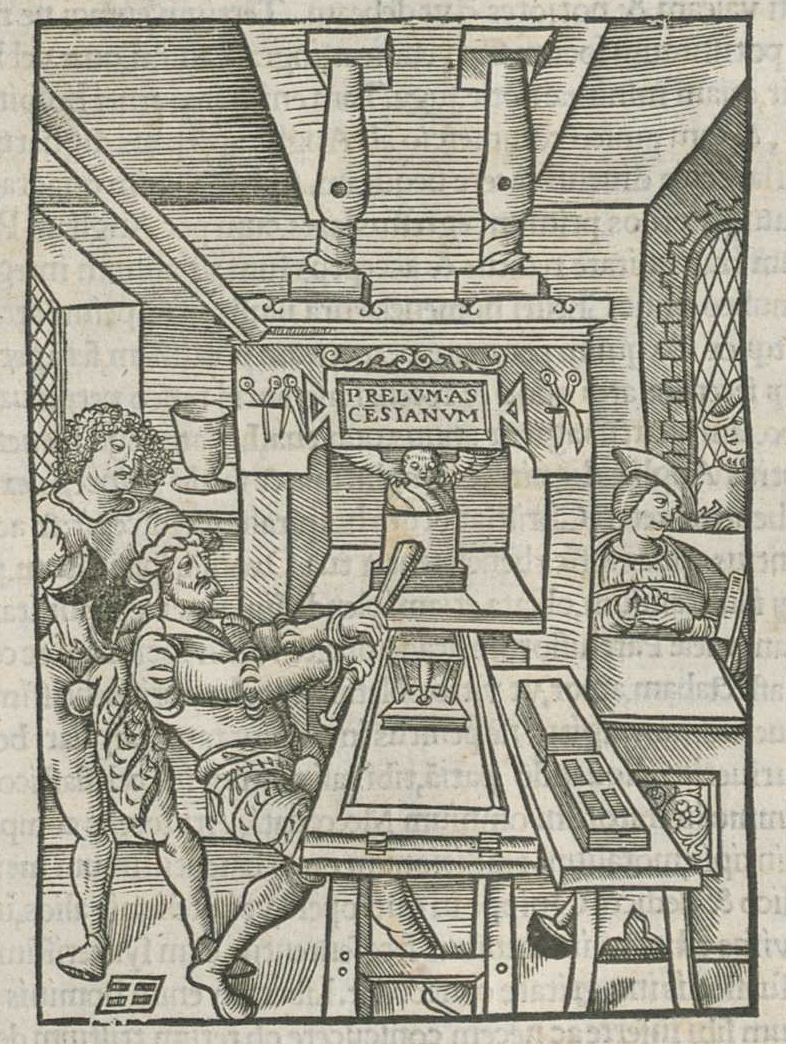| Chronological overview |
|
|
| Notes |
| Appendices |
| References |
| Index |
1521:
Jodocus Badius Ascensius | Josse Bade

Click here to enlarge the image.
Source:
Title: ‘Secundus operum tomus, in quo subsequentes continentur ejusdem commentarii’
Author: Beda
Translator: Josse Bade
Printer: enundantur Josse Bade [et] Jean Petit
Illustrator: -
Engraver: -
Location: Paris
Year: 1521
Links: [Scan],
[USTC].
Comments:
This woodcut is used until 1535 (?) by his son Conrad Badius. [USTC].
This ‘third mark’ of Josse Badius Ascensius was used in 1521. The first mark was used in 1506 (‘Ascesianum’) and 1507 (‘Ascensianum’). The second mark was used in 1520 (‘Ascesianum’) and 1520 (‘Ascensianum’)
Falconer Madan (1895), page 230: ‘Between 1529 and 1532 seems to occur a larger variety of No. 2, with a separate table bearing two piles of paper, one blank, and one with four pages printed on the upper side: a waste leaf and an ink-ball lie on the floor, and hung up on the press are three tools-shears for cutting out the tympan sheet and other purposes, compasses for testing intervals, and a screw-point for making register. The title is ‘Prelum.as | Cēsianum’ is in two lines.’
Philippe Renouard (1928) page 8: ‘Passe à Conrad Badius son fils, à Jean de Roigny et à Michel de Vascosan ses gendres.’
Abraham Horodisch (1974), page 185: ‘Im September 1529 erscheint zum erstenmal die dritte Marke (Abb. 38).’ The note refers to ‘Commentarii Linguae graecae’ by Guillaume Budé. [USTC]
Abraham Horodisch (1974) page 186: ‘Diese Druckermarke ist von Badius’ Schwiegersson und Erben Jean de Roigny unverändert übernommen und bis 1548 benutzt worden.’
Nigel Roche (2000), page 31: ‘Jodocus Badius's third mark is seen from 1529. It is very similar to G, but differs in having two compositors (as does G6), no hammer on the till, and only three tools attached to the head. The threads on the two ceiling jacks run in opposite directions. On the floor lie a dropped ink ball (frequently repeated in later images) and a printed sheet. A very large goblet is seen beside the beater's head: does this contain ink awaiting use, or is it a recognition of the thirsty nature of printing ...?’
Technique:
Woodcut
Description in publication
Abraham Horodisch (1974) ‘Buch und Buchdruckpresse im Druckersignet des 15. und 16. Jahrhunderts.’ Philobiblon. Jahrgang XVIII, Heft 3, September 1974.
Falconer Madan (1895) ‘Early representations of the printing-Press with especial reference to that by Stradanus.’, Bibliographica. Volume 1, page 230. (Illustration #7).
Nigel Roche (2000) The iconography of the printing office to 1700. Unpublished MA thesis. Library and Information Studies, University College London. (Illustration H).
Philippe Renouard (1928) Les marques typographiques parisiennnes des XVe et XVIe siècles. Paris: Champion. figure 24. [Scan]
Louis-Catherine Silvestre (1853) Marques typographiques, volume 2, page 435, no 774. [Scan].